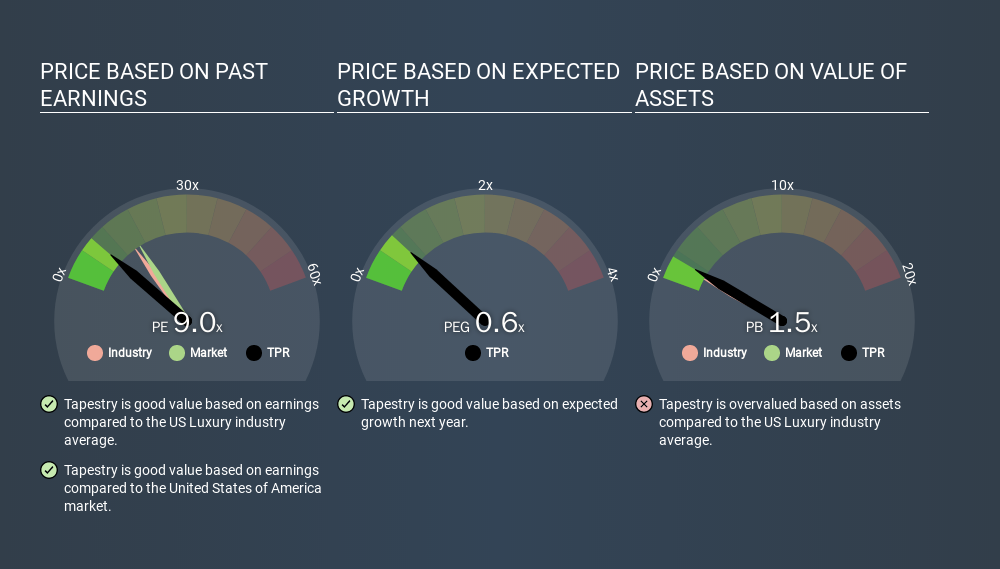- United States
- /
- Luxury
- /
- NYSE:TPR
How Does Tapestry's (NYSE:TPR) P/E Compare To Its Industry, After The Share Price Drop?
Unfortunately for some shareholders, the Tapestry (NYSE:TPR) share price has dived 34% in the last thirty days. Indeed the recent decline has arguably caused some bitterness for shareholders who have held through the 45% drop over twelve months.
Assuming nothing else has changed, a lower share price makes a stock more attractive to potential buyers. While the market sentiment towards a stock is very changeable, in the long run, the share price will tend to move in the same direction as earnings per share. The implication here is that long term investors have an opportunity when expectations of a company are too low. Perhaps the simplest way to get a read on investors' expectations of a business is to look at its Price to Earnings Ratio (PE Ratio). A high P/E implies that investors have high expectations of what a company can achieve compared to a company with a low P/E ratio.
View our latest analysis for Tapestry
How Does Tapestry's P/E Ratio Compare To Its Peers?
We can tell from its P/E ratio of 8.98 that sentiment around Tapestry isn't particularly high. If you look at the image below, you can see Tapestry has a lower P/E than the average (13.8) in the luxury industry classification.

Tapestry's P/E tells us that market participants think it will not fare as well as its peers in the same industry. Since the market seems unimpressed with Tapestry, it's quite possible it could surprise on the upside. If you consider the stock interesting, further research is recommended. For example, I often monitor director buying and selling.
How Growth Rates Impact P/E Ratios
Earnings growth rates have a big influence on P/E ratios. When earnings grow, the 'E' increases, over time. That means unless the share price increases, the P/E will reduce in a few years. Then, a lower P/E should attract more buyers, pushing the share price up.
Tapestry's earnings per share fell by 19% in the last twelve months. But EPS is up 3.8% over the last 3 years.
Remember: P/E Ratios Don't Consider The Balance Sheet
One drawback of using a P/E ratio is that it considers market capitalization, but not the balance sheet. Thus, the metric does not reflect cash or debt held by the company. The exact same company would hypothetically deserve a higher P/E ratio if it had a strong balance sheet, than if it had a weak one with lots of debt, because a cashed up company can spend on growth.
Such spending might be good or bad, overall, but the key point here is that you need to look at debt to understand the P/E ratio in context.
How Does Tapestry's Debt Impact Its P/E Ratio?
Net debt totals just 8.5% of Tapestry's market cap. The market might award it a higher P/E ratio if it had net cash, but its unlikely this low level of net borrowing is having a big impact on the P/E multiple.
The Bottom Line On Tapestry's P/E Ratio
Tapestry's P/E is 9.0 which is below average (15.1) in the US market. With only modest debt, it's likely the lack of EPS growth at least partially explains the pessimism implied by the P/E ratio. What can be absolutely certain is that the market has become more pessimistic about Tapestry over the last month, with the P/E ratio falling from 13.6 back then to 9.0 today. For those who prefer invest in growth, this stock apparently offers limited promise, but the deep value investors may find the pessimism around this stock enticing.
Investors have an opportunity when market expectations about a stock are wrong. If the reality for a company is not as bad as the P/E ratio indicates, then the share price should increase as the market realizes this. So this free visual report on analyst forecasts could hold the key to an excellent investment decision.
Of course you might be able to find a better stock than Tapestry. So you may wish to see this free collection of other companies that have grown earnings strongly.
If you spot an error that warrants correction, please contact the editor at editorial-team@simplywallst.com. This article by Simply Wall St is general in nature. It does not constitute a recommendation to buy or sell any stock, and does not take account of your objectives, or your financial situation. Simply Wall St has no position in the stocks mentioned.
We aim to bring you long-term focused research analysis driven by fundamental data. Note that our analysis may not factor in the latest price-sensitive company announcements or qualitative material. Thank you for reading.
About NYSE:TPR
Tapestry
Provides accessories and lifestyle brand products in North America, Greater China, rest of Asia, and internationally.
Moderate risk with reasonable growth potential.
Similar Companies
Market Insights
Community Narratives



